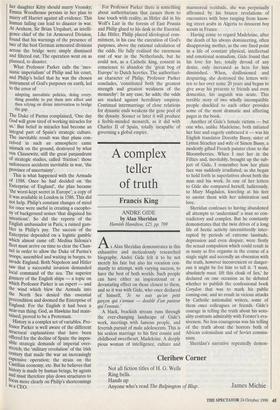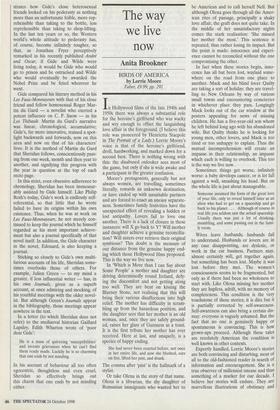A complex teller of truth
Francis King
ANDRE GIDE by Alan Sheridan Hamish Hamilton, .£25, pp. 709 As Alan Sheridan demonstrates in this exhaustive and meticulously researched biography, Andre Gide felt it to be not merely his fate but also his vocation con- stantly to attempt, with varying success, to have the best of both worlds. Such people can have either an inspirational or a devastating effect on those closest to them, and so it was with Gide, who once declared of himself, Ve ne suit qu'un petit garcon qui s'amuse — double d'un pasteur qui l'ennuie.'
A black, brackish stream runs through the ever-changing landscape of Gide's work, meetings with famous people, and feverish pursuit of male adolescents. This is his sexless marriage to his first cousin and childhood sweetheart, Madeleine. A deeply pious woman of intelligence, culture and marmoreal rectitude, she was perpetually affronted by his brazen revelations of encounters with boys ranging from know- ing street arabs in Algeria to innocent boy scouts in France.
Having come to regard Madeleine, after the death of his always domineering, often disapproving mother, as the one fixed point in a life of constant physical, intellectual and emotional nomadism, Gide found that his love for her, totally devoid of any desire, only increased as hers for him diminished. When, disillusioned and despairing, she destroyed the letters writ- ten to her over some 20 years and began to give away his presents to friends and even domestics, his anguish was acute. This terrible story of two wholly incompatible people shackled to each other provides some of the most dramatic and affecting pages in the book.
Another of Gide's female victims — but one who, unlike Madeleine, both initiated her fate and eagerly embraced it — was his English translator Dorothy Bussy, sister of Lytton Strachey and wife of Simon Bussy, a modestly gifted French painter close to the Bloomsberries. When I met her in the Fifties and, inevitably, brought up the sub- ject of Gide, I remember how her plain face was suddenly irradiated, as she began to hold forth in superlatives about both the man and his work. In one of her letters to Gide she compared herself, ludicrously, to Mary Magdalen, kneeling at his feet to anoint them with her admiration and love.
Sheridan confesses to having abandoned all attempts to 'understand' a man so con- tradictory and complex. But he constantly demonstrates that the twin drives of a long life of hectic activity intermittently inter- rupted by periods of extreme lassitude, depression and even despair, were firstly the sexual compulsion which could result in as many as five orgasms in the course of a single night and secondly an obsession with the truth, however inconvenient or danger- ous it might be for him to tell it. 'I must, absolutely must, lift this cloak of lies,' he declared on one occasion as he debated whether to publish the confessional book Corydon that was to mark his public coming-out, and so result in vicious attacks by Catholic nationalist writers, some of them once colleagues or friends. Gide's courage in telling the truth about his sexu- ality contrasts admirably with Forster's eva- siveness. No less courageous was his telling of the truth about the horrors both of African colonialism and of Soviet commu- nism.
Sheridan's narrative repeatedly demon- strates how Gide's close heterosexual friends looked on his pederasty as nothing more than an unfortunate foible, more rep- rehensible than taking to the bottle, less reprehensible than taking to shop-lifting. In the last ten years or so, the Western world's whole attitude to pederasty has, of course, become infinitely tougher, so that, as Jonathan Fryer perceptively remarked in his recently published Andre and Oscar, if Gide and Wilde were living today, it would be Gide who would go to prison and be ostracised and Wilde who would eventually be awarded the Nobel Prize and be feted wherever he went.
Gide compared his literary method in his Les Faux-Monnayeurs with that of his close friend and fellow homosexual Roger Mar- tin du Gard — a novelist who exerted a potent influence on C. P. Snow — in his Les Thibault. Martin du Gard's narrative was linear, chronological, accumulative; Gide's, far more innovative, trained a spot- light backwards and forwards, now on this area and now on that of his characters' lives. It is the method of Martin du Gard that Sheridan follows, conscientiously pass- ing from one week, month and then year to another, and signifying this progress with the year in question at the top of each recto page.
In this strict, even obsessive adherence to chronology, Sheridan has been immeasur- ably assisted by Gide himself. Like Philip Roth's today, Gide's work is endlessly self- referential, so that little that he wrote failed to have its origins within his own existence. Thus, when he was at work on Les Faux-Monnayeurs, he not merely con- tinued to keep the journal which he himself regarded as his most important achieve- ment but also a journal specifically of that novel itself. In addition, the Gide character in the novel, Edouard, is also keeping a journal.
Sticking so closely to Gide's own multi- farious accounts of his life, Sheridan some- times overlooks those of others. For example, Julien Green — to my mind a greater, if less influential writer — has, in his own Journals, given us a superb account, at once admiring and mocking, of his youthful meetings with the older novel- ist. But although Green's Journals appear in the bibliography, those meetings appear nowhere in the text.
In a letter (to which Sheridan does not refer) to the mediaeval historian Gaillard Lapsley, Edith Wharton wrote of 'poor dear Gide':
He is a mass of quivering 'susceptibilities' and invents grievances when he can't find them ready made. Luckily he is so charming that one ends by not minding.
In his account of behaviour all too often egocentric, thoughtless and even cruel, Sheridan so effectively brings out this charm that one ends by not minding either.



















































































 Previous page
Previous page